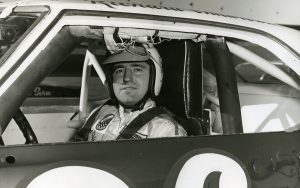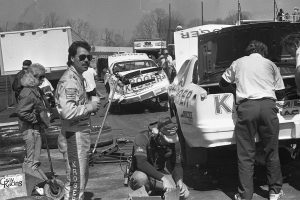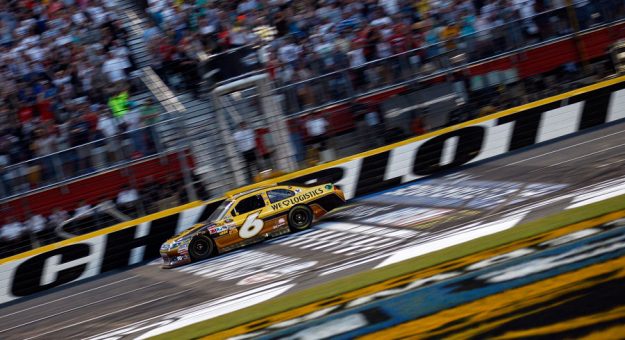Charlotte Motor Speedway has been a centerpiece of the NASCAR Cup Series since the first race was there on June 19, 1960.
The 1.5-mile track has traditionally hosted stock car racing’s longest race (600 miles) for 62 years. To many, starting the Coca-Cola 600 at Charlotte signifies that a driver has made it on NASCAR’s biggest stage.
One driver who first saw his star rise in the 600 was Dale Earnhardt, the eventual seven-time Cup Series champion and winner of 76 Cup Series races.
In the early days of his career, the native of Kannapolis, N.C., saw his name painted on the roof of Ed Negre’s No. 8 Dodge for the 1975 Coca-Cola 600. The invitation to drive came in part because Earnhardt was a fixture at Negre’s shop when he wasn’t driving his own late model sportsman car at tracks throughout the region.
Negre had been racing in NASCAR’s premier series since 1955. He was slated to drive a Dave Marcis-owned Dodge in the 600 and thanks to some heavy persuasion from Negre’s son, Norman, Earnhardt got the ride in Negre’s machine.
Earnhardt started 33rd and finished 22nd. Negre was certain he had a rising star in his car, but lacked the finances to run two full-time entries.
“I would have liked to have run two cars in Winston Cup, but I just didn’t have the money, so that was the only time Dale drove for me,” Negre said in the book, “At the Altar of Speed,” written by Leigh Montville. “…I was just a little guy, though, and didn’t have the money to back him.”
In 1978, Earnhardt was a late replacement for Willy T. Ribbs in a car fielded by Will Cronkite and supported by Charlotte Motor Speedway general manager H.A. “Humpy” Wheeler.
“Humpy called me and said, ‘I’ve sent Willy T. back to California,’” Cronkite said on the Dale Jr. Download. “You’re going to hear your name on the news. Harold Johnson, the sportscaster, could no more get the sentence out of his mouth that a change was being made when the phone rang and it was Dale. We didn’t know each other but we were having trouble with right front springs breaking … and a conversation about that.

“He asked if he could drive my car and I told him it really wasn’t my car. It’s not my deal. I’m not in charge. Dale said, ‘Do you care if I ask Humpy?’ I said, ‘I don’t care.’ A minute later Humpy called and asked, ‘Do you care if this young boy drives your car?’ I said, ‘Sure, I’d like to do that.’
“Dale called back and said we needed to fit his seat,” Cronkite continued. “I lived 52 or 53 miles away and he was there in 45 minutes.”
Over the next four hours, Earnhardt was in and out of the car constantly. Cronkite and Earnhardt worked to fit the seat in the car to Earnhardt’s exact desires, including cutting and lowering the floorboard. It was done so Earnhardt could see the cars high in the corner of the track’s first turn. Making the change would allow him to see farther into the turn.
Cronkite knew he had a great driver in his car. Earnhardt started the 600 in 28th and finished 17th.
“The light just went off,” Cronkite said. “We did all that work at 2 o’clock in the morning and he could have settled for something different. He could have asked my opinion. We could have quit early but we didn’t do that. As soon as I saw that, I was impressed. He knew what he wanted.”
That evening into early morning, 4-year old Dale Earnhardt Jr. stood inside his father’s truck with toys on the seat as his dad and Cronkite worked on that No. 96 Ford.
The younger Earnhardt went on to win 26 Cup Series races from 1997 through 2017, but never won a Cup Series points race at Charlotte Motor Speedway, though, he did win the All-Star Race there.
While driving for Richard Childress, the elder Earnhardt won three Coca-Cola 600s.
When Childress entered his first Coca-Cola 600 on May 27, 1973, he already had 28 Cup Series starts over a three-year period as a driver. The Winston-Salem, N.C., native drove a Chevrolet owned by Tom Garn, even though he formed RCR Enterprises in 1969.
Garn and Childress teamed to enter 96 Cup Series races from 1971 to ’75.
“When I drove at Charlotte Motor Speedway for the very first time, I knew so many great drivers had competed there and won there,” Childress said. “From the time I made my first laps, the track felt good to me. I started 285 Cup races in my career and had several top 10s at Charlotte. I always enjoyed racing there. Racing and winning at Charlotte has always been prestigious.”
Ernie Irvan, a beloved competitor in the NASCAR Cup Series from 1987 through 1999, won 15 races for team owners Larry McClure and Robert Yates. But he didn’t originally set out to become a NASCAR driver when he first visited Charlotte Motor Speedway in the early 1980s.
Fate brought him to the track, but racing there seemed a bit out of reach.

“It was 1982 and I just happened to move to Charlotte to do odd jobs and make a little bit of money,” Irvan said. “My dad, Vic Irvan, knew Humpy Wheeler and the folks at Charlotte Motor Speedway. They asked me if I knew how to weld and I said, ‘Yes.’ I had a job welding grandstand seats and I was paid by the unit.
“You had to do it as fast as you could or someone else would get the job,” Irvan continued. “It was actually pretty good money because they paid you by the piece. It was a section of four seats in the grandstands, so they paid you $20 a unit. I could do 20 units a day. That was decent money.
“When I was in California, the Cup Series seemed so far away. I didn’t think anything about it. It just wasn’t really part of my dreams, to be honest,” Irvan noted. “I really wasn’t dreaming. I was living year to year. I raced go-karts and stock cars and then my mom and dad split. That curbed my racing for a while. My dad told me if I ever wanted to go any further in racing, I needed to be on the East Coast.”
In 2006, David Ragan entered his first Coca-Cola 600.
Ragan began racing on the quarter-mile track at CMS with a mission to someday make it in the Cup Series.
“As a kid, even though I lived in Georgia, we raced a lot at Charlotte Motor Speedway,” Ragan said. “We would go to the track every week and we would take part in their Summer Shootout Series on Tuesday nights.”
A couple of years before his Cup Series debut, Ragan was excited to be in a position to be racing on the prestigious 1.5-mile surface where so much NASCAR history had taken place.
“I remember I was going to graduate high school in May 2004 and I had an opportunity to run the ARCA race there,” Ragan said. “That was the first time I had run laps on the big track at Charlotte. I was nervous but excited to have the chance to run a 3,400-pound stock car with 800 horsepower.
“That was unbelievable for an 18-year boy. I was getting ready to graduate high school and I did that in the morning of the Friday or Saturday of the ARCA race that evening,” Ragan added. “In the moment, you have to focus on all of the advice you’re being given and try to soak it in. I don’t think I soaked in that first experience at Charlotte as well as I should have.
“Charlotte Motor Speedway was kind of like Indianapolis Motor Speedway as far as arriving as a race driver. You hear about those stories of how Dale Earnhardt got his first start at Charlotte. Winning at Charlotte is a big deal. Everyone is based around Charlotte. Many of the team owners and the sponsors are there. Racing for Bruton Smith and Humpy Wheeler in years past has been big. There has always been something special about racing at Charlotte.”
